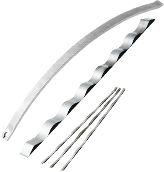Question Katayama 2007/4/21(Sat) 18:28
Could you tell me about the following three points?
1. I heard that there is a high risk of hydrogen embrittlement fracture when plating the oil-tempered wires for springs. I usually use plated springs made of hard steel wire or piano wire, but what are the differences in the surface or composition of the material, and what is the risk here?
2. What kind of high-conductivity spring materials are available?
3. What are duplex stainless steel wires?
Answer Tokai Spring 2007/4/25(Wed) 11:33
Thank you for writing to us, Mr. Katayama!
We will answer your questions as follows:
1. It is said that in general, the higher the strength of the material, the higher the risk of hydrogen embrittlement fracture is. Since the oil-tempered wire is high-strength steel material, there is a high risk of hydrogen embrittlement fracture. Hard steel wire and piano wire have a fibrous structure due to the wire drawing process in material manufacturing, making it difficult for hydrogen to enter the materials. However, it cannot be said that there is no risk of hydrogen embrittlement fracture, so it is better to avoid plating.
2. Phosphor bronze is a highly conductive spring material.
3. Duplex stainless steels are materials that have the advantages and disadvantages of austenitic and ferrite structures and have been used as materials with excellent corrosion resistance, crevice corrosion resistance in freshwater environments. They have been used in chemical, petroleum refining, energy, and a lot of other types of equipment for more than 30 years, replacing austenitic stainless steel. Recently, some cases of corrosion and cracks were reported, and the selection of the usage environment is paid more attention to. However, duplex stainless steel wires are not available as spring materials.
We are happy to answer any inquiries regarding technology, specifications, materials, etc. Please feel free to ask.

















